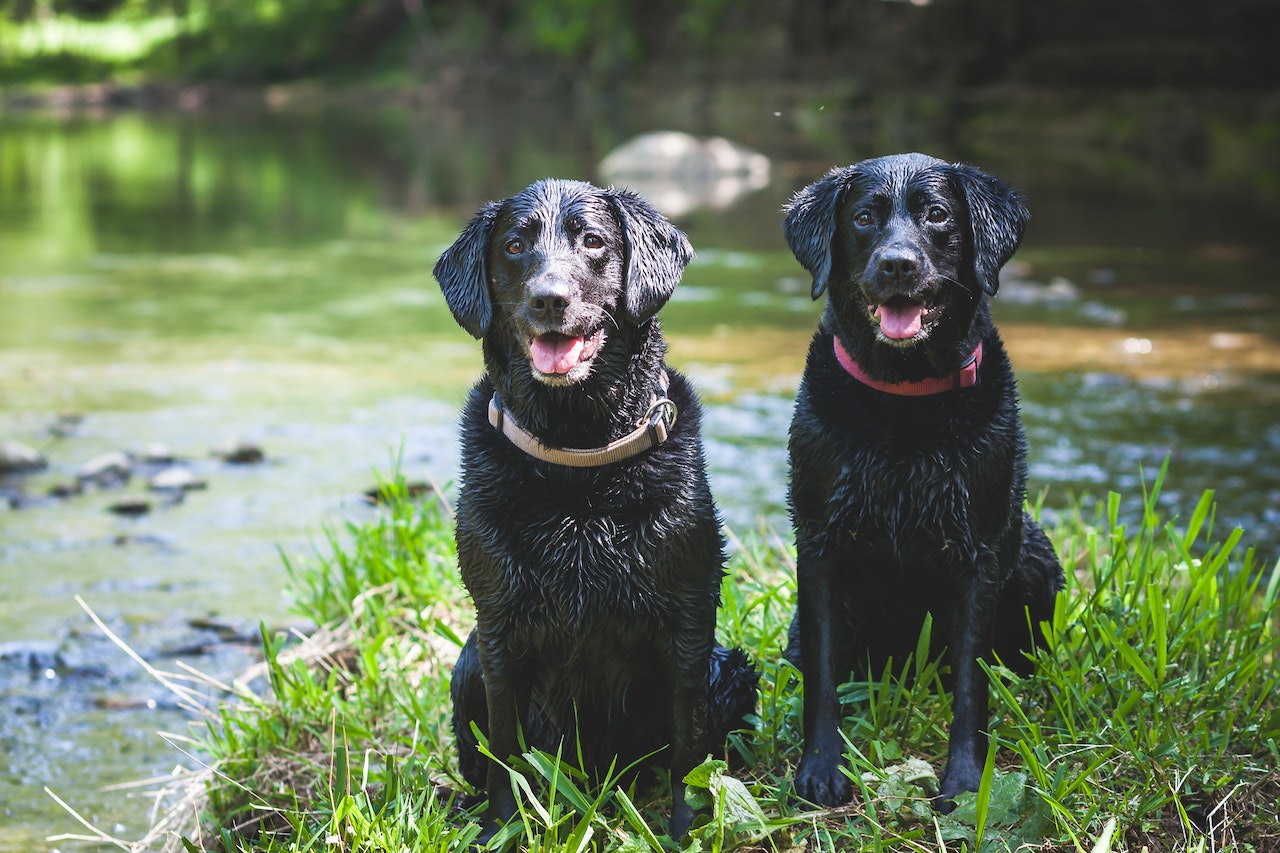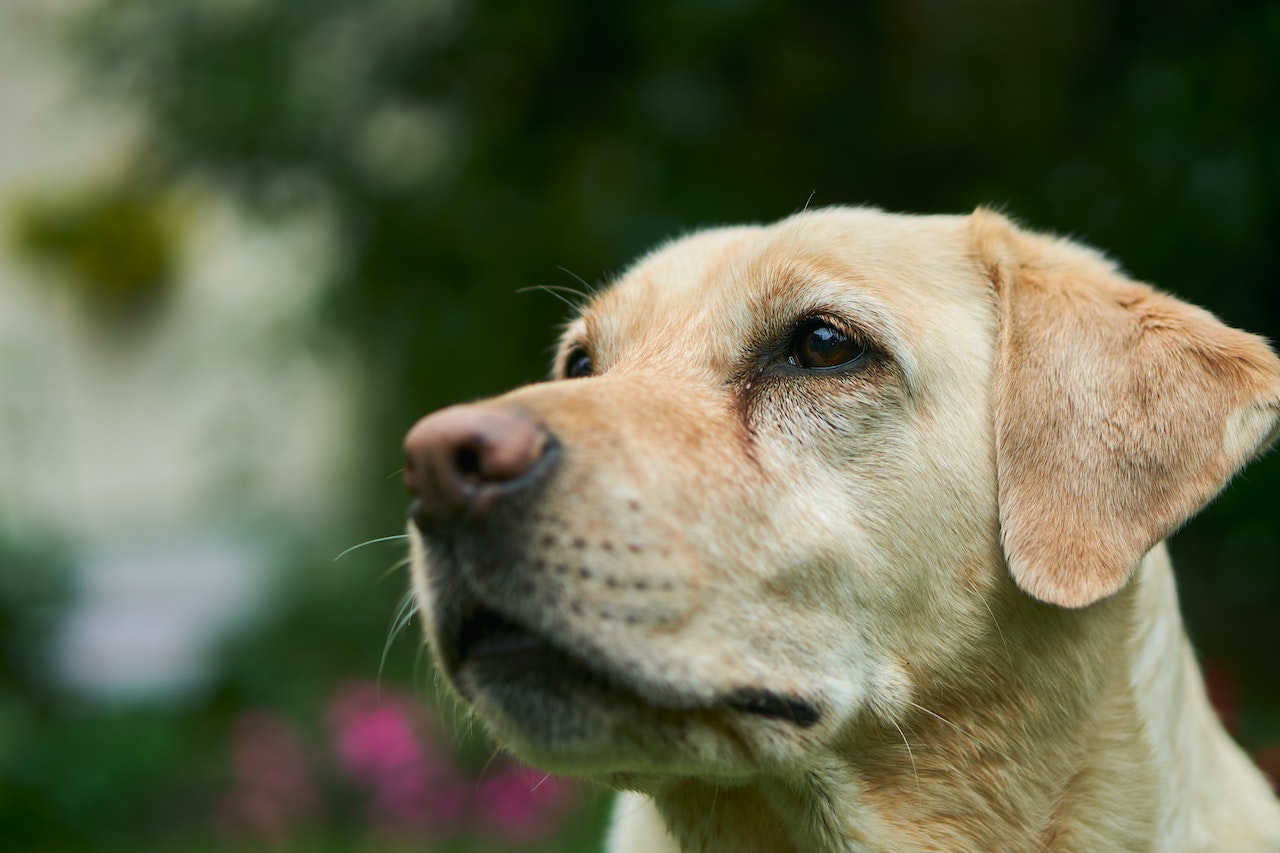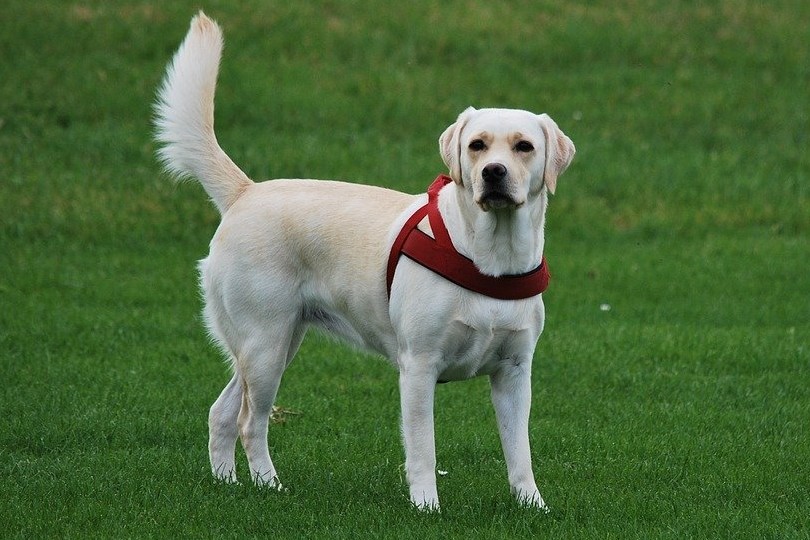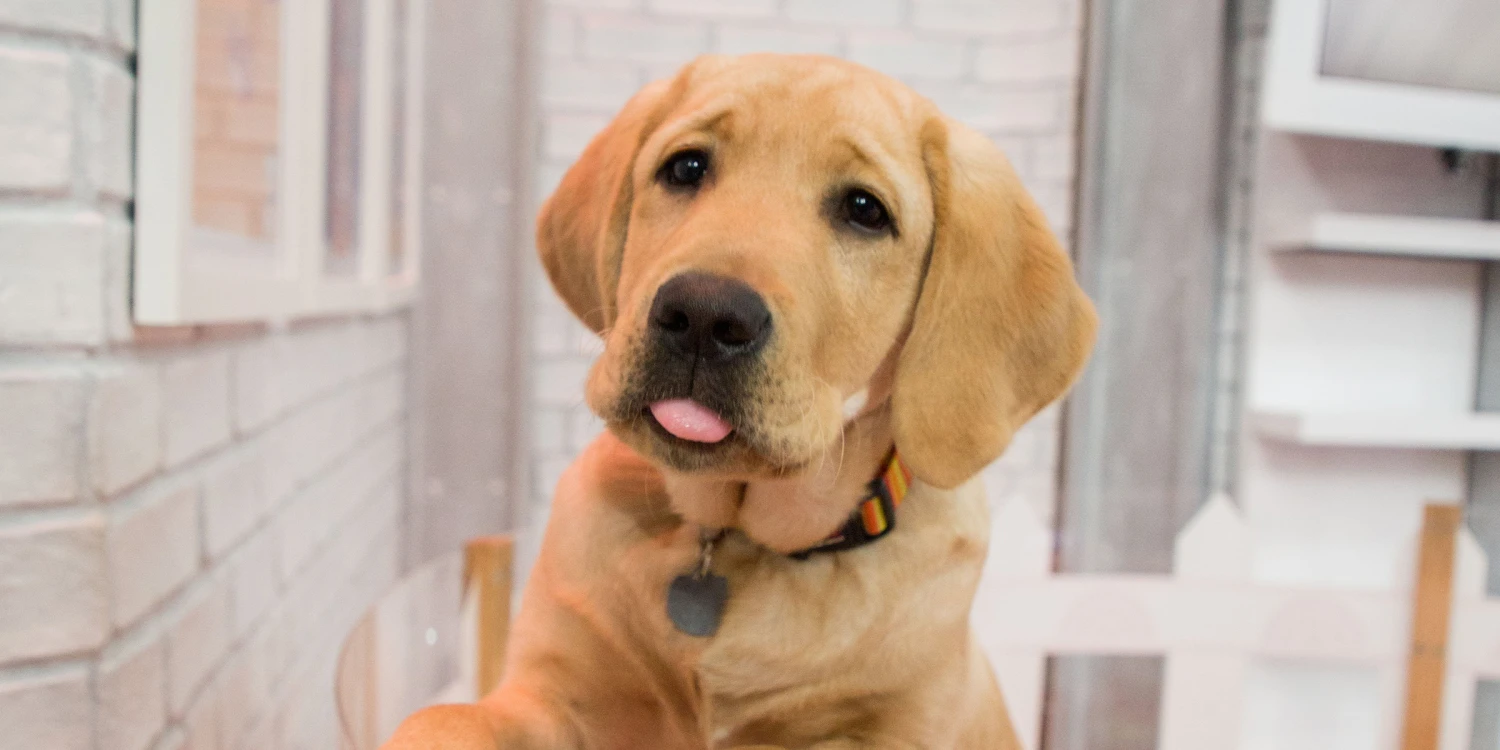
Labrador retrievers or Labs, as they are commonly known, are a wonderful combination of active and friendly, making them one of the most loved family pets. Continue reading to learn more about this popular breed of dog.
| HEAD |
|
| WEIGHT |
|
| LIFE SPAN |
|
| BREED SIZE |
|
| GOOD WITH |
|
| TEMPERAMENT |
|
| INTELLIGENCE |
|
| SHEDDING AMOUNT |
|
| EXERCISE IS A MUST |
|
| ENERGY LEVEL |
|
| BARKING LEVEL |
|
| DROOL AMOUNT |
|
| BREED GROUP |
|
| COAT LENGTH/TEXTURE |
|
| COLORS |
|
| BUT OTHER TRAITS |
|
You’re likely to have met at least one Lab in life. They are America’s most loved dog breed. Labs have won the dog personality contest for many years because they are intelligent, happy to be with their families, and enjoy being around them. They are a joy to have around and a hard worker breed.
Labs can be companionable and bond with everyone in the family. They are also friendly towards all pups and people they meet. They are energetic and need lots of activity but they are also eager to please and very trainable.
Appearance
The Labrador retriever’s role as hunter’s companion makes them strong dogs. They can weigh anywhere from 55 to 80 pounds. Labs are available in three colors: yellow, chocolate, and black. Although black Labs were a favorite among breeders initially, they are still prevalent today. Breeders may offer rare Labs such as polar white, silver or fox red. These are just variations of the original Lab colors.


Their hair is smooth and easy to maintain, provided you are willing to shed it. Their thick, short top coat is not as thick as their undercoat. Their undercoat is thicker and provides protection from the elements, particularly cold temperatures, as a nod back to their original role of retrievers.
The tail of a Lab serves another purpose. Their thick, tapered tails act as a rudder for Labs when they swim. Be careful on the ground, this happy breed will wag their tail frequently and eagerly and not stop if they are in your way.
Yellow Labs can be confused with golden retrievers. Both are gentle and friendly dogs that are loved by their families. However, they are distinct breeds.
Temperament
The breed standard states that the ideal disposition is one with a kind, outgoing, approachable nature, eager to please, and non-aggressive towards animals or men. The Labrador is a dog that people love. His gentle nature, intelligence and adaptability make him a great dog.


Labradors are sweet and outgoing dogs. Labs are very friendly with all animals and people they meet. Labs excel in personality and are highly intelligent, making them very adaptable. Labs are energetic and will need your attention. However, they can also be very relaxed at home, where you can enjoy a family movie night.
Although some believe Labs’ coloration affects their temperament, there is no scientific proof to support this claim. Many veterinarians realize that every Lab is unique and has his own personality. Some Labs can be calmer than others, while some are more energetic. Some dogs are more anxious than others. You can have Labs that are a little bit silly. No matter how much your Lab puppy develops, there is one constant: the Lab puppy will always be the Lab puppy.
Caring for a Labrador Retriever
The Labrador Retriever is a popular breed. Labradors are affectionate towards people and can be good with other dogs and children. When introducing Labradors to their families, it is important to supervise them.
Labrador Retrievers have water-repellent double coats. A layer of longer hair covers the undercoat of the short-haired Labrador Retriever. Labradors shed frequently due to their double coat. It is important to brush regularly to control the shedding.
Labrador Retrievers are water-loving and make great companions for families who love to spend time outside.
Labrador Retriever Health Issues
Labrador Retrievers are generally healthy, but owners need to be aware of potential health issues.
Ear Infections
There are two reasons Labrador Retrievers can get ear infections.
- Their ears hang down loosely which can trap moisture and wax and cause inflammation and infection in the ear canal.
- Labrador Retrievers are fond of water and swimming. However, if water gets into their ears while swimming or taking a bath, it can cause an ear infection.
An ear infection could be characterized by:
- Redness in the ear canal
- Ear canal debris: Brown or yellow
- Head shaking
- Head tilt
- Using your carpet/furniture to rub your ears
- Odor in the ears
- Pawing at the ears
Labrador Retrievers are at greater risk for ear infections if they have an ear cleaner with a drying agent, such as EPIOTIC (r) Advanced. This should be done every 2 to 3 week for maintenance.
Tricuspid Valve Dysplasia


The tricuspid valve is responsible for pumping blood from the right side to the ventricle. Labrador Retrievers suffering from tricuspid valve dysfunction (TVD), a condition that causes blood to leak into the right atrium and prevents it from functioning properly, have a defective valve. The right atrium and right ventricle grow larger over time.
Labrador Retrievers suffering from TVD might have a heart murmur, which can be detected during routine physical exams. They may be asymptomatic, or they could show signs of right-sided cardiac failure.
- Coughing
- Fluid in the abdomen
- Abdominal swelling
- Difficulty in breathing
- Rapid heart rate
TVD is typically diagnosed using a patient’s history, physical exam and chest x-rays. ECG and echocardiogram are also used. Sometimes, surgery can be done to replace the tricuspid with a prosthetic valve from a cow or porc. This condition is often managed with heart medications.
Based on the severity of the disease, the prognosis for TVD in Labrador Retrievers may vary. TVD in Labrador Retrievers can lead a normal life. It is not a good idea to breed Labradors with TVD or a family history of TVD.
Elbow Dysplasia
The umbrella term elbow dysplasia refers to several inherited orthopedic conditions which eventually lead to degenerative joint disease (DJD). Labrador Retrievers may have:
- Ununited anconeal processes (UAP)
- Osteochondritis dissecans (OCD)
- Medial compartment disease (MCD).
- The incongruity between the elbow and shoulder
Lameness can occur in any of these conditions, particularly after exercise. A veterinarian will often check the elbow’s range of motion to detect pain.
Sometimes, elbow dysplasia can affect both elbows. This condition is most commonly diagnosed by X-rays and advanced imaging (CT scans).
For elbow dysplasia, orthopedic surgery may be required. A good prognosis is usually possible if the surgery is performed when the dog’s health is still young and the disease is in its early stages. Labrador Retrievers who have had elbow dysplasia in the past should not be bred.
Hip Dysplasia
Hip dysplasia refers to an inherited condition in which the hip joint’s head is not properly aligned with the femur. The femoral head rubs against the socket of the hip, leading to osteoarthritis.
Hip dysplasia may affect one or both of the hip joints. Congenital hip dysplasia is a rare condition in Labrador Retrievers. Others develop it as a result of ageing. These are the symptoms:
- Lameness
- Slowness in rising from a lying down position
- Running with bunny-hopping gait
- Reluctance or inability to run, jump or climb stairs
- When sitting up, keep the affected leg straight out to the side.
PennHIP can be used to screen puppies as young 16 weeks old. This procedure requires anesthesia or sedation. To determine which dogs are most likely to develop hip dysplasia in their lifetime, specialized x-rays are taken of the pelvis. Early treatment is possible by identifying these dogs with a PennHIP assessment.
The severity of hip dysplasia will determine the treatment options. Hip dysplasia may be treated with medications, supplements, or reduced activity. To correct the problem, a dog might need surgery.
Centronuclear Myopathy



Centronuclear myopathy is a rare congenital disorder that affects the skeletal muscles. This condition can cause impairment of reflexes in the hindlimbs.
A clinical sign is an abnormal gait or inability to do any type of exercise. In colder environments, the muscles can become weaker. Labradors usually experience symptoms between 2-5 months old. The dog’s neck, head, and leg muscles usually become weaker by the age of 1, which can lead to continued gait problems and weakness. After one year, the condition will stabilize.
This condition can be diagnosed by a muscle biopsy. Genetic therapy is the best treatment. To determine if your Labrador Retriever is carrying the CNM genetic mutation, DNA testing can be done. Reputable breeders will test their dogs and not breed Labrador Retrievers with the genetic mutation.
Exercise-Induced Collapse
EIC is an inherited neuromuscular disorder that affects the hind legs. EIC can cause a Labrador Retriever to experience episodes of reduced muscle tone in their hind limbs due to intense exercise or excitement. Incoordination in walking or even collapse can occur when the hind limbs suddenly weaken.
Dogs generally recover but may have to go through more episodes. A dog’s rectal temperature may reach 107 during an episode. This is considered life-threatening. Labrador Retrievers suffering from EIC often have episodes starting around 12 months old. If your dog has EIC, your veterinarian will help you decide the best course of action.
To determine if a Labrador Retriever is at risk of EIC, a DNA test can be performed. Do not breed dogs with genetic mutation.
Hemangiosarcoma
Hemangiosarcoma is a deadly form of cancer. It usually originates in the liver, spleen or heart of Labrador Retrievers.
These are some of the clinical signs:
- Weakness
- Pale gums (white)
- Fluid in the abdomen (ascites).
- Insatiable appetite
- Difficulty in breathing
Hemangiosarcoma spreads quickly to other parts of the body. At first, it may not be visible with imaging (xrays, ultrasound or CT/MRI). The prognosis for this type of cancer is very grim.
Nutritional Dilated Cardiomyopathy
Labrador Retrievers can develop nutritional dilated cardiomyopathy (nutritional DCM), a form of heart disease that is caused by eating a diet without grains and which includes peas, lentils, legumes, and lentils as the top five ingredients. DCM can cause the heart to become dilapidated and make it difficult to function.
Labrador Retrievers suffering from mild to moderate DCM might be symptomatic. In severe cases, symptoms may include rapid heartbeat, difficulty breathing, coughing, difficulty swallowing, lethargy, and lack of appetite.
A veterinarian may detect a heart condition by detecting a murmur in the heart during a routine examination. Another test that measures heart function is called the NT-proBNP assay. Additional testing may be required to rule out the possibility of a Labrador Retriever having an elevated proBNP level and/or a murmur in their heart.
It is possible to reverse nutritional DCM if it is caught early. This can be done by giving the dog high-quality grain food and providing heart supplements. It is impossible to reverse the disease once it has advanced. Heart medications may be used for temporary relief. This condition can be prevented by giving your Labrador a balanced diet, which includes grains.
Progressive Retinal Atrophy


Progressive retinal atrophy (PRA), a form of eye disease, can be caused by a variety of genetic mutations. Over time, the retina gradually degenerates leading to permanent dilation and eventually blindness.
An eye exam can diagnose PRA. Labrador Retrievers usually get it between 3 and 9 years old.
Although gene therapy might be beneficial for dogs suffering from this condition, more research is needed to confirm its effectiveness. For PRA, reputable breeders will test their dogs for genetic mutations. These genetic mutations are not acceptable for breeding.
What to feed a Labrador Retriever
Labrador Retriever puppies need to be fed high-quality puppy food made for large breeds up until the age of one year. They will need to be transitioned to a high-quality adult formula for large breeds once they turn adults.
Talk to your veterinarian about the best dog food that is not grain-free in order to avoid any complications from nutritional dilated cardiomyopathy. This heart condition can be avoided by a grain-free diet that includes legumes, peas, and lentils as the top five ingredients.
You should ensure that the Association of American Feed Control Officials approves any dog food you purchase.
How to feed a Labrador Retriever
Labrador Retrievers thrive on twice-daily feedings: morning and evening. Labrador Retrievers love to eat and can eat quickly. If you notice your dog gobbling food down, consider a slow-feeding device. This will limit how much food your dog can consume at once and prevent them from getting upset stomachs or regurgitation.
Labrador Retrievers have deep chests. If they eat too fast, this can cause bloat. This is an emergency situation in which the stomach twists around itself.
How much to feed a Labrador Retriever
Labrador Retriever puppies grow quickly so make sure to give them high-quality puppy food when they are less than 12 months old. Puppy food will give them the extra calories they need in order to reach their full potential. The large-breed puppy food bag contains guidelines for feeding your dog. These guidelines are based on your puppy’s age and weight.
To prevent weight gain, you can switch to an adult formula that is high-quality and larger-breed. To decide how much food to give your Labrador Retriever you need to review the bag’s feeding guidelines and talk to your veterinarian about the best portions to keep your dog at a healthy weight.
Nutritional Tips for Labrador Retrievers
A Labrador Retriever can be started on a joint supplement as early as possible to slow down or even prevent arthritis. Virbac Movoflex and Synovi Chews, Dasuquin and Cosequin, Flexadin, Flexadin, and Synovi Chews are just a few of the joint supplements that have been tested and proven to be effective.
A Labrador Retriever should also consider omega-3 fatty acids (fish oil) as a supplement. The supplement reduces inflammation in joints and makes the coat shiny. It also protects the skin barrier against allergens. Nordic Naturals Omega-3 PET, Vetoquinol Triglyceride Omega-3 Fatty Acids, and Nutramax Welactin Omega 3 are all good options for fish oil supplements.
Labrador Retriever Training Tips and Behavior



Labrador Retriever Temperament and Personality
Labrador Retrievers are a great breed. Labrador Retrievers are affectionate towards children, pets, and strangers.
They are very active and love to play. To make them happy, they need to be active and have lots of attention.
Labrador Retrievers are considered moderate barkers. They don’t dig in the yard. Labrador Retrievers rarely show aggression.
Labrador Retriever Behavior
Labrador Retrievers are prone to eating things that they shouldn’t, especially as puppies. Some Labrador Retrievers will eat shoes, socks, furniture, and other objects, as well as the trash. Keep an eye out for your puppy and take the time to teach them what they can and can’t eat.
Barking can be stopped by redirecting barking behavior early on and looking for better outlets.
Labrador Retriever Training
Labrador Retriever puppies can be very energetic and can grow up to be very strong dogs. When they are young, it is important to properly train them.
Labrador Retriever puppies should be trained in obedience and puppy training. Dogs need to become comfortable with other pets and people so that they can be around them at an early age.
You must correct any poor behavior in your puppy immediately. This includes biting, chewing on objects and trying to eat random things.
Fun Activities for Labrador Retrievers
- Scent work
- Tracking
- Agility
- Training in obedience
- Dock diving
Labrador Retrievers are able to go through special training to become service dogs, or take part in search and rescue or drug detection. They are also great therapy dogs.
Labrador Retriever Grooming Guide


Labrador Retrievers do not require much grooming. However, they shed a lot. Brushing and de-shedding are important aspects of your daily, weekly and monthly grooming routines.
Skin Care
Labrador Retrievers don’t require special skin care regimens. However, it is important to dry Labrador Retrievers completely after baths and swimming to avoid any skin problems.
Coat Care
Labrador Retrievers have thick double coats that are water-repellent. Double coats are made up of a thick layer of long hair and a thicker undercoat. Labrador Retrievers shed frequently due to their double coat. Labrador Retrievers need to be brushed regularly to control the shedding.
Labradors need to take a bath every now and again to maintain their skin and hair.
Eye Care
Labrador Retrievers can sometimes have mild brown or clear eye discharge. This is normal. To clean out the eye discharge, it is a good idea to use a dampened washcloth.
Take care of your ears
Labrador Retrievers can get ear infections from their love of swimming and their prone ears. To reduce the chance of developing ear infections, it is a good idea to clean their ears regularly with an ear cleaner containing a drying agent (such as EPIOTIC(r), or Advanced) at least once a week.
Considerations for Pet Parents
Labrador Retrievers make great family pets. Labrador Retrievers are friendly and energetic dogs who love to travel with their families. Their energy and strong tails can make them dangerous for young children and toddlers.
Labrador Retrievers are also high-shedding dogs. Dogs with high shedding will require constant brushing. However, dog hair can remain in your home permanently.



Labrador Retriever FAQs
Is a Labrador Retriever a good family dog?
Labrador Retrievers are great family dogs. They are gentle and affectionate, and they can be trusted around children and other dogs.
Are Labradors Retrievers smart dogs?
Labrador Retrievers can be very intelligent and are easy to train. Labrador Retrievers are eager to please, and they will soon learn many tricks to get the praise and treats they deserve.
What are the downsides to Labrador Retrievers?
Labrador Retrievers shed lots because of their dual-layer coat. To minimize their shedding, they need to be brushed frequently. They are very active and need to be exercised.
Labrador Retrievers can get ear infections easily. Labrador Retrievers should have their ears cleaned regularly with an ear cleaner that includes a drying agent. This is recommended for Labrador Retrievers every 2-3 weeks. They also tend to eat things they shouldn’t–especially as puppies–so taking the time to train them properly at a young age is important.
Labradors may develop nutritional dilated cardiomyopathy (a condition that causes a labrador to become ill from consuming a diet without grains, which includes legumes, lentils, and peas as the top five ingredients. They are also susceptible to hip dysplasia and elbow dysplasia. These are mostly genetic predispositions that are less likely to be present in Labrador Retrievers purchased from reputable breeders.